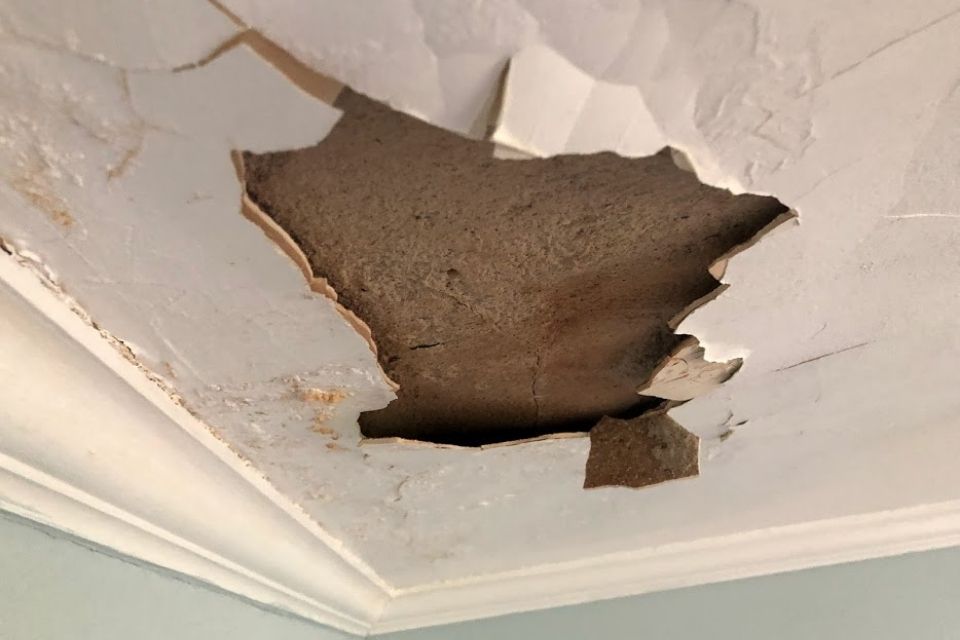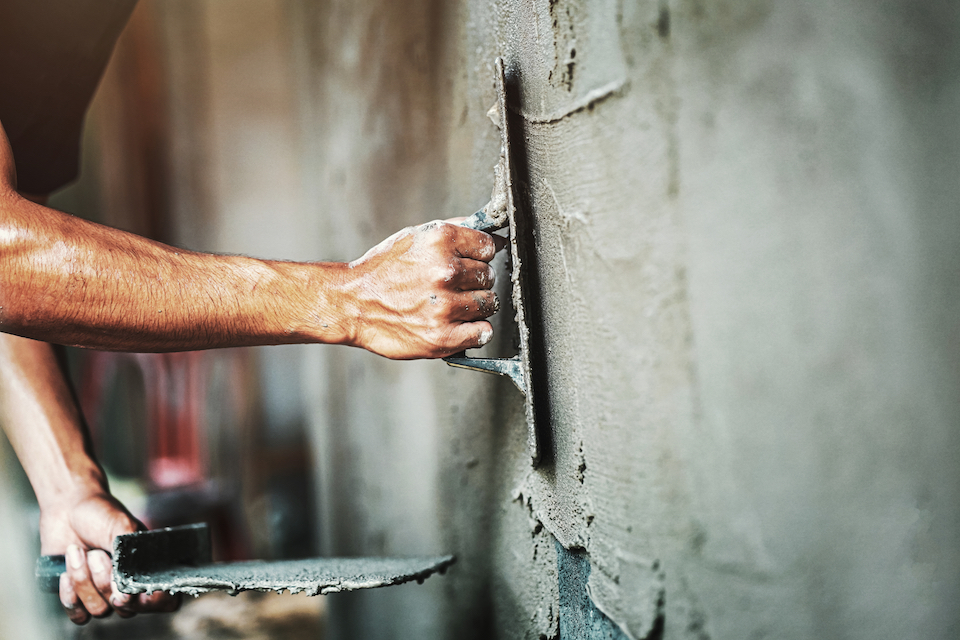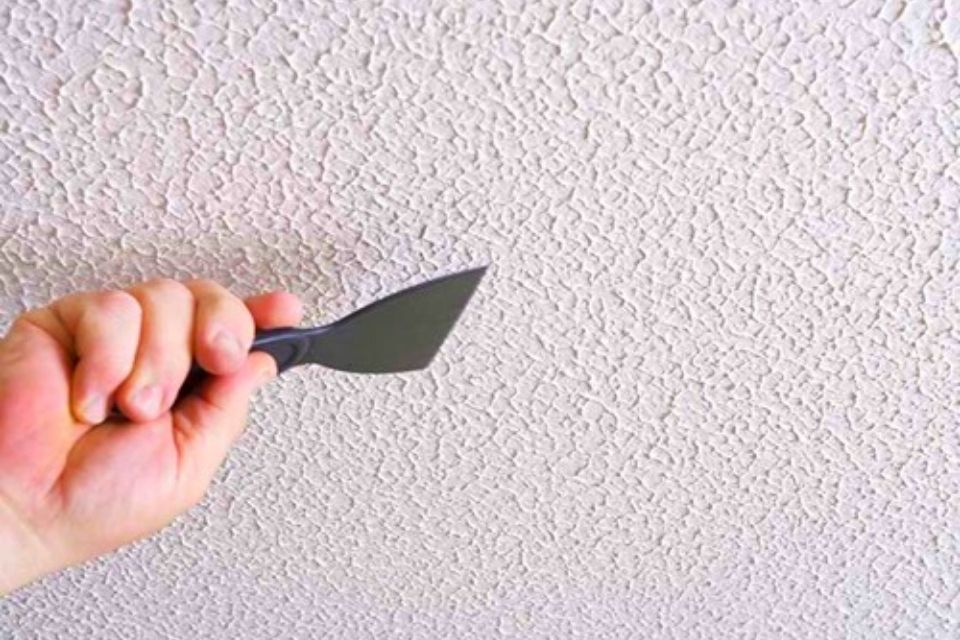Condensation on Ceiling
Over time, condensation might accumulate and gradually deteriorate a ceiling. Eventually, this can lead to cracks, holes and even destabilise the entire ceiling, not to mention its impact on the appearance of the ceiling.
Condensation may accumulate on a ceiling as a result of insufficient insulation and ventilation in the loft.
This could be the result of humidity. Moisture may come from bathing, cooking, or clothes drying, and when it makes contact with the ceiling, with it being a warmer surface, condensation will form.
The most obvious sign of condensation on the ceiling is the sight of dampness, whether across much or most of the ceiling or, more likely, in the form of damp patches.
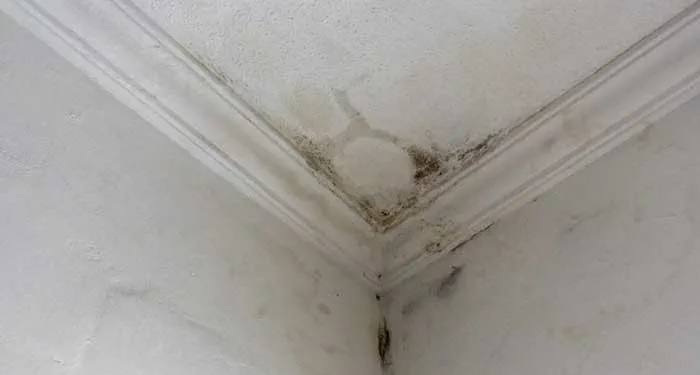
Beyond that, a musky, damp odour may be present in the room if there is a significant amount of condensation on the ceiling.
Watermarks on the flooring or dripping water from the ceiling are further evidence that there are substantial amounts of condensation gathering on the ceiling.
There are three broad solutions to fixing this issue, and the best approach or mix of approaches (and how you prioritise those approaches) will depend on the nature of the issue.
Firstly, fixing ceiling condensation can be achieved by reducing how much moisture is being created in your home or, at the very least, in the room where the ceiling damage is occurring.
This might mean moving appliances around, not drying clothes in the room with this problem and so forth. You should also look at improving insulation and ventilation for the room or/and loft above.
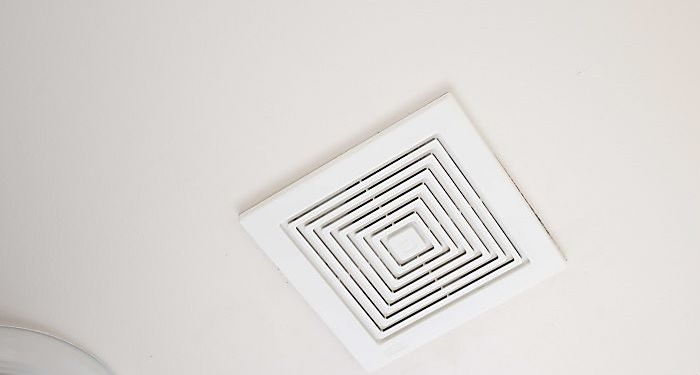
These three tactics can significantly reduce moisture in the air. It's also worth considering purchasing a dehumidifier.
However, it may be necessary to fix the ceiling itself. If the condensation does not appear to have caused much damage, then you could wait and see if the initial solutions work.
If, however, you find that you do notice some issues with the ceiling, then you may need to have some parts of the ceiling replaced through replastering and perhaps, repainting.
You should hire a professional for plaster ceiling crack repair as it is a complex job. That is unless you have some relevant experience and plenty of knowledge when it comes to this work.
However, you could save money by dealing with the paintwork. Internal insulation work is doable for most DIY enthusiasts, but it is best to hire a professional if it involves external work. Ventilation can also generally be dealt with on a DIY basis.
Black Spots on Ceiling
Another fairly common problem that can arise with ceilings is the appearance of black spots. These spots are essentially black mould that can appear on a whole host of surfaces and facilities in a home.
They are basically a form of corrosion. One identifiable trait of black spots is that they tend to be quite similar in conformation and size.
Most of the time, this can be fixed as a DIY job, and a professional will not be needed. With that said, it's important that you take the right approach and are sure that the issue is black dots on the ceiling and not something else.
In order to clean this type of mould from the ceiling, you should wash the area with the black spots using a water-washing up liquid combination or a mould cleaner.
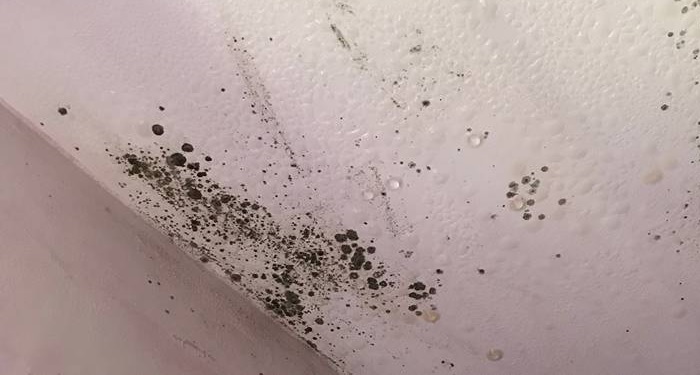
Once you've cleaned it, you should try the area off before applying bleach. A quarter of a cup of bleach and a quarter cup of water should be applied with a sponge or spray bottle. Then, dry the area off once more.
This should solve the problem, for now at least. With that said, mould likes to spread, and if there is plenty of humidity in the room or your house in general, then it remains prone to the issue returning.
For that reason, the three steps discussed in the prior section, ventilate, insulate, and reduce moisture, should be employed.
Keeping on top of any signs or presence of mould elsewhere in your home is the best way of dealing with this issue and stopping it from becoming a recurring issue.
Sagging Ceiling
One of the main causes of a ceiling that is sagging is an accumulation of moisture. You may notice some parts of a ceiling hanging slightly lower than the rest of the ceiling. Dampness may also be noticeable in this area.
Plasterboard can warp when it becomes very damp. Overflowing tanks in the attic and burst pipes may cause such severe damage that the ceiling can even collapse.
Another possible explanation is that the ceiling was not fitted correctly in the first place, such as that not a sufficient number of screws were installed to begin with.
In general, old ceilings can warp and sag with time, such as if laths in a ceiling were installed without sufficient gaps between them or the old plaster was not mixed with enough hair reinforcement.
Coats of plaster may also separate as time passes. Another less likely cause of a sagging ceiling is a beetle infestation, overloading, and vibrations.
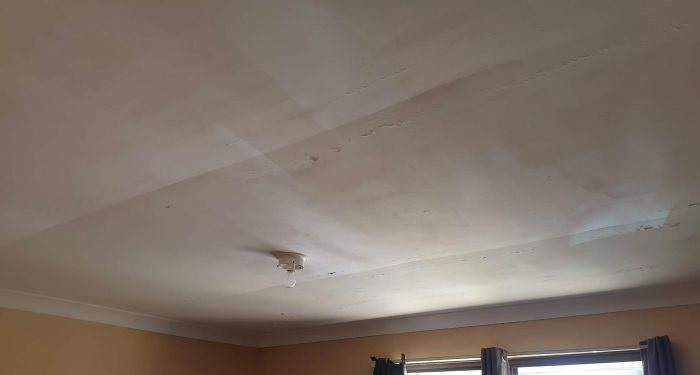
The first step to fixing this problem involves identifying the cause and resolving this issue first.
Once this has been accomplished, you'll need to cut out the sagging section of the ceiling and replace it with a fresh infill piece and plaster.
If there are boards with insufficient support, added drywall screws should be installed for fixing a sagging ceiling. Any board should be fitted to the joists with screws present with intervals of 150mm between them.
For old lath and plaster ceilings with particularly bad sagging, it can be propped up with a plywood sheet and timber.
This will temporarily hold it back in place before rapid setting plaster can be applied along the line of gaps between each lath. The prop should only be removed once the area has fully dried.
As discussed in the 'condensation on ceiling' section, it is generally best to hire a professional for plastering work.
It's essential that you correctly identify the cause of the sagging problem. If you are, in any way, unsure, you should hire a professional contractor to identify the issue.
Ceiling Cracks
Another problem that can occur with a ceiling is the emergence of cracks. As with a sagging ceiling, it may simply be that the property is old and wear and tear has simply left its mark.
Then again, as with a sagging ceiling, there are many possible explanations, including excess weight on the ceiling from above (e.g. water tank or other heavy items, appliances, or furniture in the room above), or quite often, from water damage.
The drywall may also have been installed incorrectly, and it's also possible that there are foundation issues.
Further, a poor ceiling installation could be the explanation, as could attached wooden ceiling joists if they are contracting and expanding.
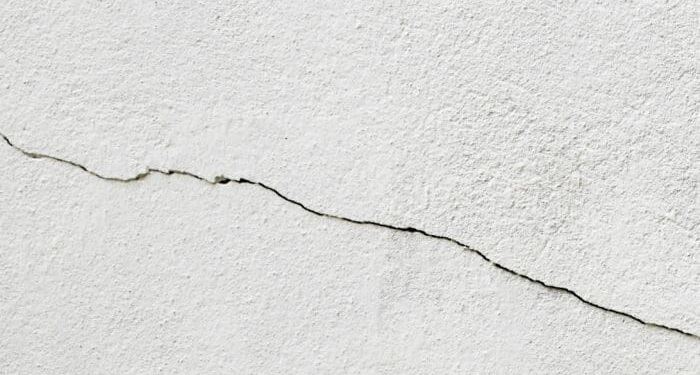
Small spider web ceiling cracks tend to be harmless, so long as they are no more than about 0.15cm in width.
If they are, then the issue is likely worse. It is best to hire a professional to inspect and solve this problem unless the cracks are particularly small.
If they aren't especially large, ceiling crack repair may be undertaken as a DIY job. To do so, you should first lay down sheets of plastic before scraping off any loose debris or paper from the drywall.
Next, fit one piece of mesh drywall to cover the crack. The tape should then be covered by two layers of five-minute mud, with each layer sanded over. Lastly, the patched crack should be painted over.
If this problem goes unresolved, the issue will likely worsen, and it can worsen structural problems and may even result in the ceiling collapsing. For that reason, it's vital that ceiling cracks that are a structural risk are dealt with right away.
Ceiling Specialist Cost
The best tradesperson to hire for any job is a specialist in the area. If plastering or Artex work is necessary, you'll likely be charged somewhere in the range of £8 to £19 an hour, though it will depend on where you live.
This is because plasterers, like any labourers, charge different rates in different parts of the country due to varying living costs.
If a roofer's assistance is needed for particularly extensive work, this would cost about £20 to £30 per hour. The costs of repairing a ceiling will depend on the type of ceiling and the nature of the issue.
For drywall, it would cost about £30 to £35 per m2 to replace a whole ceiling due to a water leak, £110 to £140 for each repair, to fix peeling paint, £9 to £13 per m2 if you need to have hairline cracks filled and the same amount to fill settlement cracks.
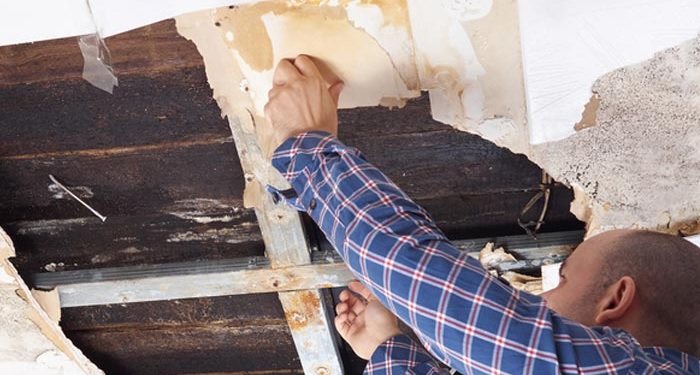
In the case of a lath & plaster ceiling, you can expect to pay about £30 to £40 per m2 to replace a ceiling, £120 to £170 for each repair, to resolve peeling paint, or £14 to £19 per m2 to fill hairline cracks or settlement cracks.
A suspended ceiling costs approximately £20 to £40 per m2 to replace an entire ceiling, and the same estimated price range applies to fixing peeling paint.
An emergency repair may cost two to three times that of a normal hourly price. This would apply if you needed to hire a plasterer ASAP because you've suddenly realised that water damage has arisen, significantly weakening the ceiling.
Or perhaps the ceiling is deteriorating rapidly, where it appears that parts of the ceiling or the entire ceiling is close to collapsing.
FAQs
Q: Is a large hole in the ceiling classed as an emergency?
A: Any hole or leakage in the ceiling is an emergency that should be dealt with ASAP by a professional. For this reason, you should stay out of the room for safety reasons and call up a local contractor.
There is no telling how much more damage might occur if the issue is not dealt with as soon as possible. From large sections of the ceiling collapsing to the issue fundamentally impacting the entire property's structure.
Q: Can small cracks be repaired on a DIY basis?
A: Yes. It is generally feasible and safe for a DIY enthusiast to fill small cracks in a ceiling. Sometimes these cracks are not even a hazard or risk to the ceiling but may only act as an aesthetic problem.
Either way, small cracks are usually fine to deal with on your own, so long as you understand the steps involved.
Q: What safety equipment should I wear to fix a ceiling? And how much do they cost?
A: For ceiling work you're undertaking by yourself, at the very least, you should wear a dust mask and safety goggles. Most dust masks cost roughly £1 to £5 per unit, and safety goggles cost £3 to £15 each.
Q: How long does ceiling repair take?
A: It will depend heavily on the extent and nature of the work. Fixing a few small cracks may only take an hour or less, but replacing a ceiling might take up to a day of work.
Q: If my ceiling collapses, will it be covered by insurance?
A: Homeowner insurance should cover a collapsed ceiling in the vast majority of cases. However, it will depend on the cause. If this issue has arisen, you should contact your insurer as soon as possible.
Sources
- https://www.reimerroofing.com/blog/attic-condensation-in-winter-what-causes-it-how-to-prevent-it/
- https://www.diy.com/ideas-advice/how-to-repair-a-ceiling/CC_npci_100096.art
- https://www.bayareaunderpinning.com/are-ceiling-cracks-serious-causes-of-ceiling-cracks-and-when-to-worry/
- https://clearcutpainting.co.uk/how-to-repair-cracks-in-ceilings/

